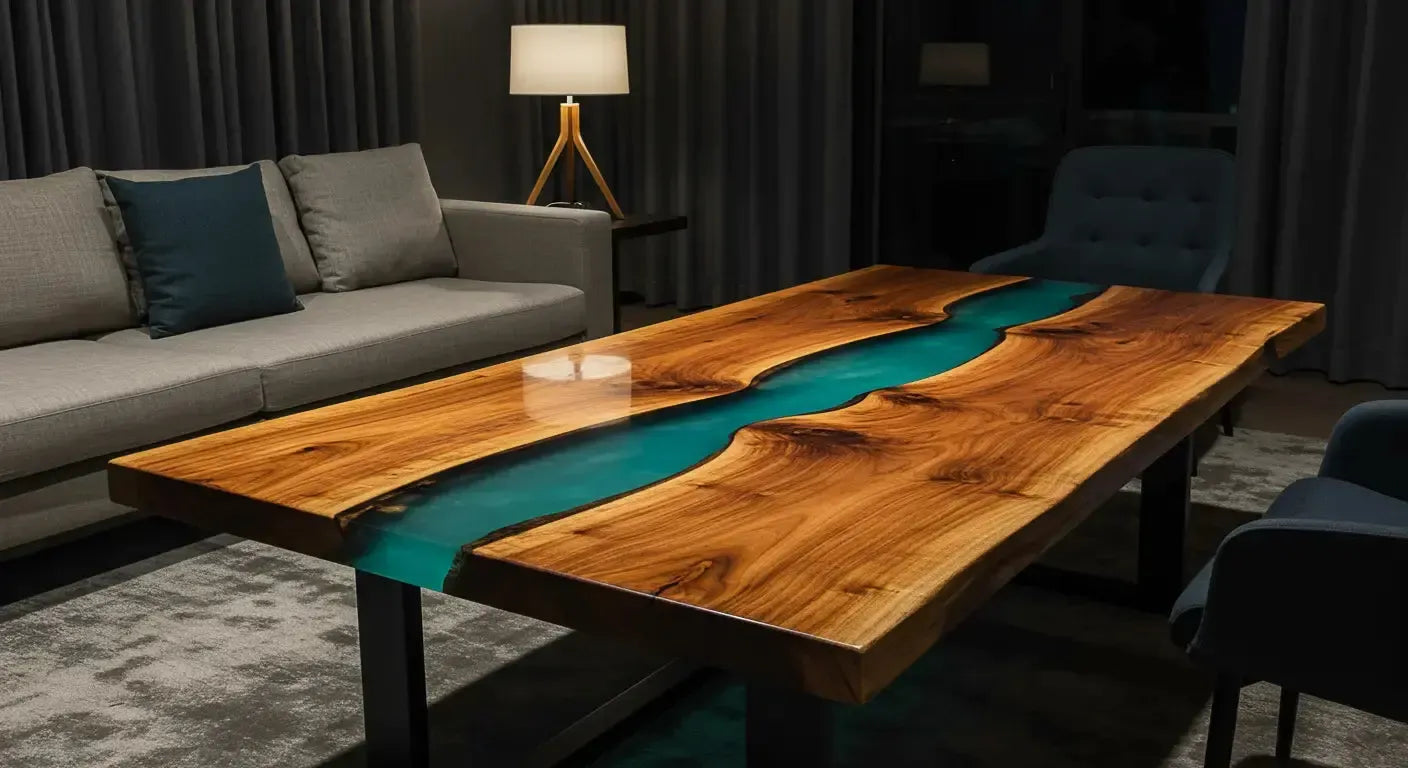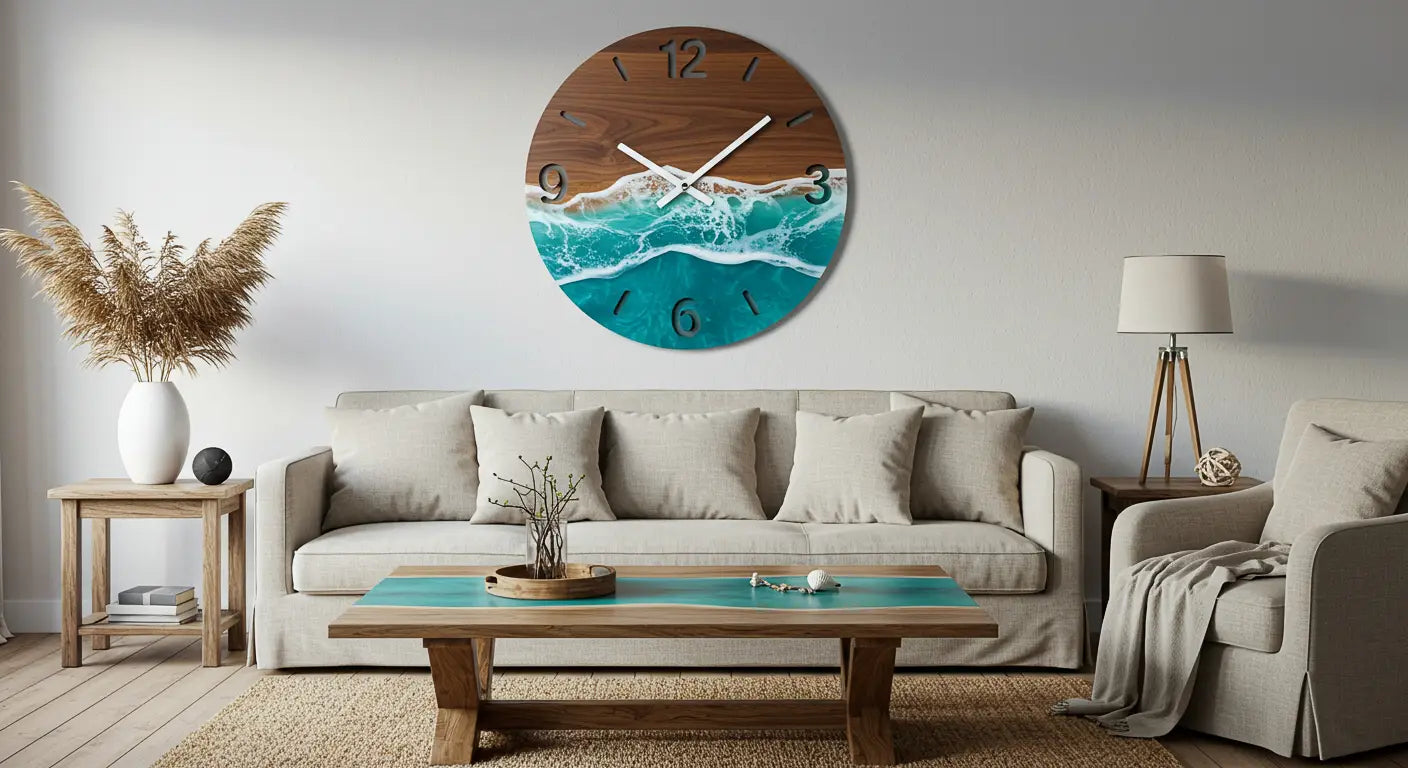If you're comparing finishes for your next table project and wondering, "Should I go epoxy or polyurethane?" — I've been there. I’ve built tables using both. I’ve messed up pours. I’ve sanded down yellowed coats. And I’ve lived with the results. So here’s the real breakdown of epoxy vs. polyurethane table tops—what worked for me, and where each one shines.

Why I Tried Both (And What I Learned the Hard Way)
Epoxy was my first love — thick, glossy, dramatic
My earliest builds were all about that glassy, high-gloss epoxy finish. It looked incredible under studio lights and stopped people in their tracks. You can see some of those dramatic pieces in our epoxy river table collection.
Polyurethane came later — more subtle, but surprisingly tough
When I started doing more minimalist and everyday-use pieces, I switched to poly—and was surprised by how easy and forgiving it was.
Here’s how they held up in real use (not just on paper)
This isn’t theory. These are finishes I’ve actually lived with—tables I’ve eaten on, moved around, and had clients come back about.

The Look: Gloss Bomb vs. Natural Feel
Epoxy: Deep, glassy finish — a total showstopper
You want that “museum art piece” shine? Go epoxy. It’s thick, reflective, and makes pigment and wood grain explode with depth.
Poly: Matte to satin — lets the wood speak for itself
Polyurethane gives a smoother, more natural finish. It doesn’t yell at you. It just sits there and looks clean.
My call: Epoxy if I’m going for luxury, Poly if I want quiet class
- Epoxy for river tables, statement builds, or artistic pieces.
- Poly for everyday-use or flooring projects.
Durability: Who Took More Abuse?
Epoxy: Great for impact and wear, but can scratch or yellow over time
Epoxy’s thick coat can take hits. But it’s more prone to fine scratches from keys, grit, or dragging objects. And cheap epoxy? It’ll yellow faster in sunlit rooms. I’ve shared more on that in my yellowing breakdown here.
Poly: Surprisingly resistant to scratches, but needs reapplication faster
Polyurethane handles daily wear better—especially satin finishes that hide scuffs. But it can wear down faster in high-use areas.
For heavy use: I still lean epoxy — with a good UV-resistant topcoat
Epoxy holds up better if you’re dealing with lots of movement or weight. But it needs help (like a poly or varnish topcoat) for long-term UV resistance.

Heat, Spills, and Real-Life Use
Epoxy doesn’t love heat — mugs and pans can leave marks
I’ve had resin blush or soften under hot pans. Even mugs can leave rings if you’re not careful. I covered that more in my post on epoxy and heat resistance.
Poly holds up better to casual heat but isn’t bulletproof either
Satin poly resists heat a bit better, but I still wouldn’t risk a hot skillet. Both finishes need trivets.
I keep coasters on both now, just to play it safe
No matter what finish you use—hot + wet = risk. Easy to prevent with a little habit change.
Application: One’s a Beast, One’s a Breeze
Epoxy: Messy, stressful, but fun if you like the process
Epoxy is a whole event. You mix, pour, torch, pray. One mistake, and you’re stuck sanding for hours. Here’s what helped me: a lot of trial and error.
Poly: Simple to brush on, easier to fix mistakes
Polyurethane brushes or sprays on clean. If you mess up? Sand it back and reapply. No stress. No panic.
If you’re new: Start with poly. If you’re all in? Epoxy’s worth the ride.
Poly’s beginner-friendly. Epoxy is advanced, but rewarding once you’ve got the rhythm down.

Cost: Material and Time Both Count
Epoxy kits are pricier and need more prep/tools
Expect to spend $80–$150+ just on resin. Plus: molds, tape, heat gun, torch, sander, polish, and more.
Poly is cheaper and quicker — less labor, fewer disasters
You can get a can of good polyurethane for under $30, but prices vary. And the learning curve? Way gentler.
For clients who want budget custom? Poly’s my go-to. For wow factor? Epoxy all day.
If someone wants clean and functional, poly is perfect. If they want a conversation piece? Epoxy wins.

My Takeaway: Use the Right Finish for the Right Table
Epoxy: Great for statement pieces, river tables, heavy-duty tops
If you want to embed materials, build a river table, or show off swirling pigments—this is your finish. See what’s possible in the epoxy river tables collection.
Poly: Perfect for everyday tables, desks, and flooring projects
Clean. Quiet. Practical. Poly gets out of the way and lets the wood shine without shouting.
Sometimes I even use both — epoxy base with a poly topcoat
Yep, you can layer. Epoxy first for structure and beauty, then seal it with poly for durability and UV defense.
I’m not an expert—just sharing what I’ve learned from working with these materials firsthand. I would definitely recommend researching more. This video by Aluminite on YouTube is a great place to get started if you want to dive deeper into the differences.
Thanks for taking the time to read—I really appreciate it. I hope something in my process (or my mistakes) helps you along the way. If you want a custom piece or hit a wall building your own, feel free to drop a comment or reach out—happy to help. Have a blessed day!








Share: